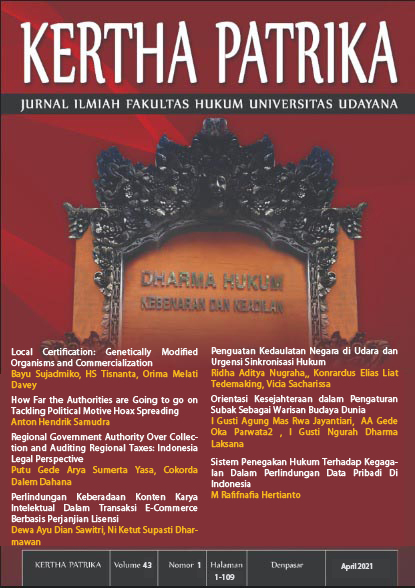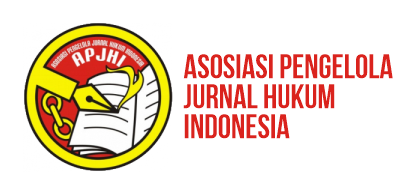How Far the Authorities are Going to go on Tackling Political Motive Hoax Spreading
Abstract
This paper identifies hoax as a cyberspace social problem which can have a negative impact toward public order, both in cyberspace and real life. It also elaborates how a hoax is different from fake news for its characteristic. A hoax could cause horizontal conflict, especially in Indonesia when it is about the most recent common political commodities, which are race, ethnicity, religion, intergroup (SARA). Every government has interest on maintaining public order to keep the sustainability of society. Criminal law is designed to be the ultimate tool of social engineering through deterrence effect. The problem is how far the law enforcement is going to go to eradicate the hoax spreading, because the issues of freedom of speech/information.The research is conducted by using a conceptual approach in a normative legal study. Secondary data also provided in this paper to grasp the factual problems as the threat that needed to be encountered. The first part of the paper elaborates the freedom of speech/information, cyberspace, and social media. The second part is explanation of profile of hoax in Indonesia. The third part is elaboration of criminal statutes of hoax distribution using information communication technology. The last part is on how far the government and law enforcement synergize and how far they going to go in handling hoaxes and the sources to prevent and contain further damage. The findings are the blocking and taking down is not just about depraving internet user’s rights, but balancing between the freedom and public order. In order to be justifiable and balanced, the government needs to consider objectively whether the content was a threat that disrupting public order (moreover, national security), while the law enforcement could confiscate the electronic system involved and it should have been through appropriate criminal procedure.
Downloads
References
Anderson, R. (2008). Security Engineering: A Guide to Building Dependable Distributed Systems (2nd ed.). Indiana: Wiley. Retrieved from http://www.citeulike.org/user/brothers/article/5106718
Cross, N. (2010). Criminal law & criminal justice: An introduction. Criminal Law and Criminal Justice: An Introduction. SAGE. https://doi.org/10.4135/9781446288283
Dworkin, R. (1996). Freedom’s Law: The Moral Reading of the American Constitution. Oxford: Oxford University Press.
Hudson, B. A. (1993). Penal Policy and Social Justice. Macmillan – UK.
Leisti, S. (2017). Digital Era and Social Media Shaping the World. In P. Hallberg & J. Virkunnen (Eds.), Freedom of Speech and Information in Global Perspective (p. 239). New York: Palgrave Macmillan-Springer.
Melkonian, H. (2012). Freedom of Speech and Society: A social approach to freedom of expression. New York: Cambria Press.
Smith, R. G. (2011). Human Rights Infringement in the Digital Age. In K. Jaishankar (Ed.), Cyber Criminology: Exploring Internet Crimes and Criminal Behavior (pp. 393–409). Boca Raton London New York: CRC Press Taylor & Francis Group. https://doi.org/10.1201/b10718
Soesilo, R. (1996). Kitab Undang-undang Hukum Pidana (KUHP) serta Komentar-komentarnya Lengkap Pasal Demi Pasal. Bogor: Politeia
Kemitraan & Lembaga Kajian dan Advokasi Untuk Independensi Peradilan. (2019). Naskah Akademik Kerangka Hukum Perolehan, Pemeriksaan, dan Pengelolaan Bukti Elektronik. Tanpa Penerbit.
Journals
Akimzhanov, T., Alayeva, G., Bishmanov, K., Lyutsik, V., & Ryzhkova, I. (2017). About the Implementation of International Standards And Limits Of Reception Of Foreign Experience To The Sphere Of Execution Of The Punishment In The Republic Of Kazakhstan. Astra Salvensis, V(Supplement No. 1), 25–35.
Bayles, M. (1974). Criminal Paternalism. In The Limits of Law: Nomos XV (p. 175).
Brenner, S. W. (2010). Cybercrime: criminal threats from cyberspace. Choice Reviews Online (Vol. 48). https://doi.org/10.5860/choice.48-0685
Dession, G. H. (1947). Sanctions, Law and Public Order. Vanderbilt Law Review, Yale Law S.
Held, G. (1999). Are You Prepared for an Internet Hoax? International Journal of Network Management, 9.
Jaishankar, K. (2008a). Establishing a Theory of Cyber Crimes, 1(2), 7–9. https://doi.org/10.5281/zenodo.18792
Jaishankar, K. (2008b). Space transition theory of cyber crimes. Crimes of the Internet, (January 2008), 283–301.
Mitnick, K. D., & Simon, W. L. (2003). The Art of Deception: Controlling the Human Element in Security. BMJ: British Medical Journal. Indiana: Wiley. https://doi.org/0471237124
Rubin, V. L., Chen, Y., & Conroy, N. J. (2015). Deception detection for news: Three types of fakes. In Proceedings of the Association for Information Science and Technology (Vol. 52, pp. 1–4). MO, USA. https://doi.org/10.1002/pra2.2015.145052010083
Salam, A. (2018). The Hoax Phenomenon in Indonesian Society: Observing Anti-Diversity Memes since 2014. Humaniora, 30(3)
Utami, P. (2018). Hoax in Modern Politics:The Meaning of Hoax in Indonesian Politics and Democracy. Jurnal Ilmu Sosial Dan Ilmu Politik, 22(2), 85–97. https://doi.org/10.22146/jsp.34614
Yoanita, D., Hadi, I. P., Setiawan, A., Aritonang, A. I., & Maureen, V. (2019). Spirit of writing and sharing as motives of kompasiana users. Test Engineering and Management, 81(11–12), 2050–2062.
Websites
CNN Indonesia. (2016). There are 800 thousand sites of hoax distributor in Indonesia. Retrieved July 20, 2018, from https://www.cnnindonesia.com/teknologi/20161229170130-185-182956/ada-800-ribu-situs-penyebar-hoax-di-indonesia
Detik Finance. (2008). Kisah si Penyebar Rumor Perbankan. Retrieved August 13, 2018, from https://finance.detik.com/bursa-dan-valas/d-1037940/kisah-si-penyebar-rumor-perbankan
Griffiths, M. D. (2017). The Psychology of Hoaxing: Why do individuals deliberately try to mislead others? Retrieved July 20, 2018, from https://www.psychologytoday.com/us/blog/in-excess/201705/the-psychology-hoaxing
Harris, B., & Brickley, S. (2018). Purposes and Functions of Law. Retrieved from http://www.businesslawbasics.com/chapter-3-purposes-and-functions-law-1
Internet World Stats. (2019). Top 20 countries with the highest number of internet users. Retrieved from https://www.internetworldstats.com/top20.htm
Jawa Pos. (2017). 1.900 hoax issues arise ahead of DKI Jakarta governor election. Retrieved July 24, 2018, from https://www.jawapos.com/nasional/pemilihan/18/04/2017/1900-isu-hoax-muncul-jelang-pencoblosan-pilkada-dki-jakarta
Lamb, K. (2019). Fake news spikes in Indonesia ahead of elections. Retrieved February 28, 2020, from https://www.theguardian.com/world/2019/mar/20/fake-news-spikes-in-indonesia-ahead-of-elections
Liputan 6. (2018). Survey: Social media as the main source of hoax spreading. Retrieved from https://m.liputan6.com/tekno/read/2854713/survei-media-sosial-jadi-sumber-utama-penyebaran-hoax
Maharani, T. (2019). Ministry of communication and informatic identified 486 Hoaxes in April 2019, 209 are political. Retrieved from https://news.detik.com/berita/d-4532182/kominfo-identifikasi-486-hoax-sepanjang-april-2019-209-terkait-politik
Sulistya, R., Almas, P., & Dwinanda, R. (2018). No new suspect in Ratna Sarumpaet hoax case. Retrieved November 20, 2019, from https://m.republika.co.id/berita/en/national-politics/18/11/09/phx436414-no-new-suspect-in-ratna-sarumpaet-hoax-case
Susilawati, D., & Putri, W. D. (2017). The impact of hoax news. Retrieved August 9, 2018, from https://www.republika.co.id/berita/trendtek/internet/17/04/11/oo7uxj359-begini-dampak-berita-hoax
VOA Indonesia. (2018). Money politic, Hoax dan SARA threat for Region Head dan Presidential election. Retrieved July 20, 2018, from https://www.voaindonesia.com/a/politik-uang-hoax-dan-sara-ancaman-pilkada-dan-pilpres/4268990.html
Walden, M. (2018). Ahead of 2019 Election, Indonesia, Media Battle Fake News. Retrieved December 20, 2019, from https://www.voanews.com/east-asia-pacific/ahead-2019-election-indonesia-media-battle-fake-news
Others
Abrams v. United States. 250 U.S. 616 (1919).
Tempo. (2017). Hoax epidemic: Fake news splatter in cyberspace, 4.











